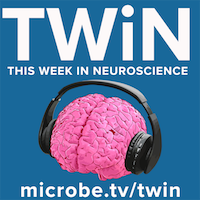TWiN reveals how oligodendrocytes enhance axonal energy metabolism by transcellular delivery of a protein, SIRT2, that deacetylates mitochondrial proteins.
TWiN discusses the finding that rewiring retinal projections to the auditory thalamus in ferrets leads to visually responsive cells that are typical of cells in the visual cortex.
TWiN answers listener questions on sex in neuroscience studies, rotating memories in the brain, odorant receptors in the brain, and neutrophils that promote neuron survival.
Ioana and Robert join TWiN to discuss their work demonstrating that rodents acquire maternal behavior by social transmission from an experienced mother to a virgin female how to care for a litter via endogenous oxytocin.
Bruce Carter joins TWiN to discuss the peripheral nervous system: the development of nerves that convey sensory information like touch from the tips of your toes to the brain, and Schwann cells, which are necessary for ensuring that those sensory signals are sustained as they travel long distances to the brain.
TWiN explores a study of hallucination-like perception in mice which supports the idea that hallucinations arise as faulty perceptual inferences due to elevated dopamine in the striatum.
On this episode, Vivianne gives a primer on glial cells, with the goal of thinking about the central nervous system holistically and appreciating the different cell types that contribute to its function.
Mauro Costa-Mattioli joins TWiN to discuss how his laboratory dissects the contribution of host genetics and the microbiome in complex neurodevelopment disorders such as autism spectrum disorders.
Michael Nitabach joins TWiN to discuss the finding that the nematode C. elegans, which do not have eyes, can discriminate between colors to guide foraging decisions and move them away from harmful bacteria that produce a blue-pigment toxin.
Stefano joins TWiN to discuss his work on understanding genomic decoding of neuronal depolarization by stimulus-specific transcriptional regulators.





